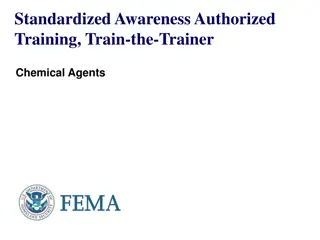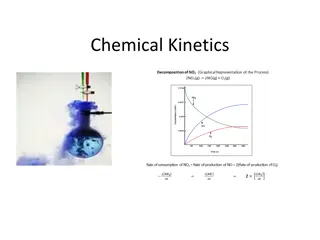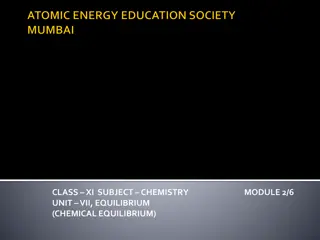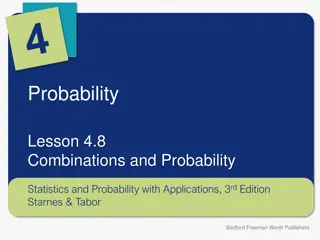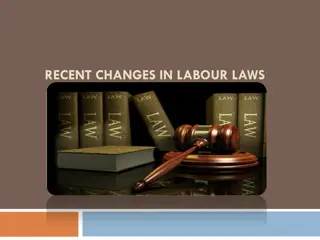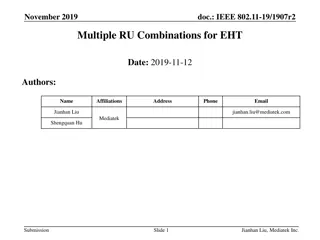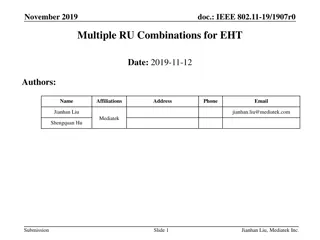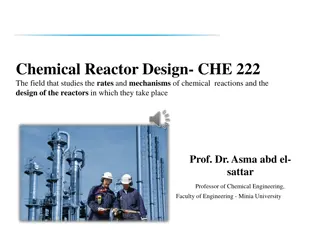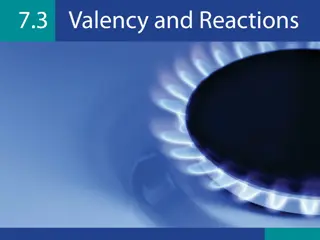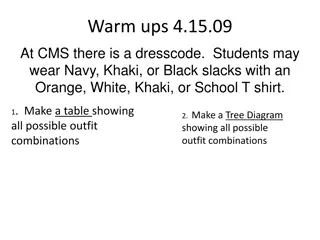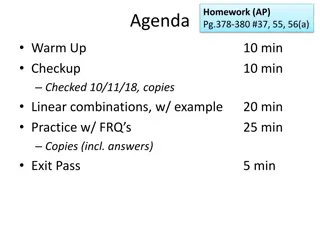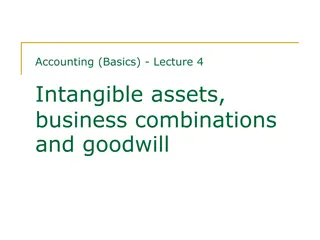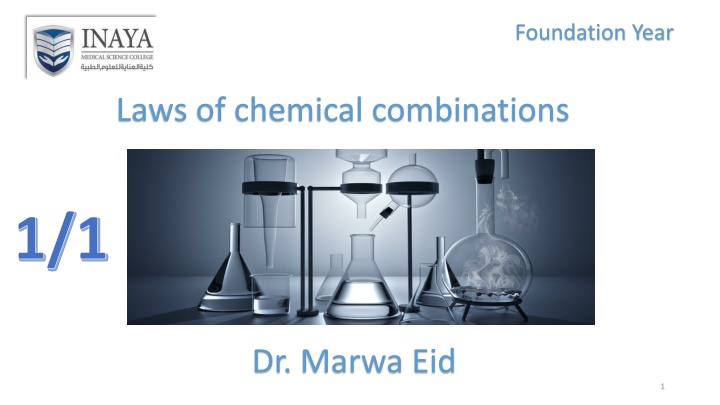
Chemical Laws: Conservation of Mass, Definite Proportions, and More
Explore the fundamental laws of chemistry, including the conservation of mass, definite proportions, and combining volumes. Learn about key principles like Dalton's atomic theory and modern atomic theory through examples illustrating the laws in action.
Download Presentation

Please find below an Image/Link to download the presentation.
The content on the website is provided AS IS for your information and personal use only. It may not be sold, licensed, or shared on other websites without obtaining consent from the author. If you encounter any issues during the download, it is possible that the publisher has removed the file from their server.
You are allowed to download the files provided on this website for personal or commercial use, subject to the condition that they are used lawfully. All files are the property of their respective owners.
The content on the website is provided AS IS for your information and personal use only. It may not be sold, licensed, or shared on other websites without obtaining consent from the author.
E N D
Presentation Transcript
Foundation Year Laws of chemical combinations 1/1 Dr. Marwa Eid 1
Objectives Objectives The law of conservation of mass The law of definite proportions The law of multiple proportions The law of combining volumes(Gay Lussac s law of gaseous volumes) Dalton s atomic theory Modern atomic theory 2
The law of conservation of mass The law of conservation of mass Lavoisier (France 1789) states that: Mass can neither be created nor destroyed in a chemical reaction This means that during a chemical reaction the sum of the masses of the reactants are equal to the sum masses of products. = Mass Massof Products of Products Mass of Reactants Mass of Reactants 3
The law of conservation of mass The law of conservation of mass Example(1) 9.2 g of sodium bicarbonate on reaction with 30 g of acetic acid (CH3COOH) liberated 5.8 g of carbon dioxide gas into atmosphere. What is the mass of residue left? Solution 9.2 + 30 = X + 5.8 X = 39.2 5.8 = 33.4 g It proves the law of conservation of mass 4
The law of conservation of mass The law of conservation of mass Example(2) Which of the following chemical reaction indicates that mass is conserved 5
The law of conservation of mass The law of conservation of mass Solution Which of the following chemical reaction indicates that mass is conserved Because atoms must be equal on each side of the equation: The correct answer is B 6
The law of conservation of mass The law of conservation of mass Example(3) Suppose that 100 gm of iron metal rust. The rust has been weigh and it was 143 gm can you find the weight of oxygen which react with iron metal. Solution(3) Iron + O Iron + O2 2 100 gm + X = 143 gm 100 gm + X = 143 gm O O2 2= 143 Rust iron Rust iron = 143- -100 = 43 gm 100 = 43 gm 7
The The L Law of aw of D Definite Constant Composition Constant Composition efinite P Proportions roportions Joseph Proust (France 1799) A given compound always contains elements in a certain proportion by mass The ratios by mass of the elements in that compound are fixed independent of the origins or preparation of that compound. A compound is unique because of the specific arrangement and weights of the elements which make up that compound. (GR) 8
The law of definite proportions The law of definite proportions 9
The law of definite proportions The law of definite proportions Example (1): H2O is always made up of 2 atoms of H and one atom of O. The ratio of O to H in water is always 16:2 or 8:1. Example (2): KCl always contains one atom of K for every one atom of Cl In KCl, potassium and chlorine always have a ratio of 39.09 to 35.45 or 1.1 to 1 by mass. 10
The law of definite proportions The law of definite proportions Example (3): What is the experimental percent of oxygen in CO2 if 45 g of carbon reacted completely with 110 gm of oxygen? Solution % = (Portion/total)*100 %O2 = (mass of O2/Total Reactant mass )* 100 %O2 = 110/(45+110) = 70.9% 11
Example (4): 12
The law of multiple proportions The law of multiple proportions Proposed that the same elements that make up one compound could also make up another compound When the same two elements combine to form more than one compound: X+ Y G X+Y M the ratios of the mass of one element in the first compound to its mass in the second compound, (as it combines with the same mass of the other element). 13
The law of multiple proportions The law of multiple proportions Carbon combines with oxygen to form CO and CO2 14
The law of multiple proportions The law of multiple proportions Example (1) Example (1) A sample of sulfur dioxide with a mass of 10.00 g contains 5.00 g of sulfur. A sample of sulfur trioxide with a mass of 8.33 g contains 3.33 g of sulfur. 1. What is the mass of oxygen in the sample of sulfur dioxide? 2. What is the mass of oxygen in the sample of sulfur trioxide? 3. For a fixed mass of oxygen in each sample, 15
The law of multiple proportions The law of multiple proportions Example (2) In the carbon compounds ethane (C2H6) and ethene (C2H4), what is the lowest whole number ratio of H atoms that react with the same number of C atoms? H : C Compound 1 6:2 = 3:1 Compound 2 4: 2 = 2:1 3 : 2 Ratio 16
The law of multiple proportions The law of multiple proportions Example (3) Hydrogen and oxygen forms two compounds. The hydrogen content in these compounds is 42.9% and 27.3%. Prove these compounds agree with the law of multiple proportions. Hydrogen Oxygen H : O Compound 1 42.9 g 100-42.9 = 57.1 g 42.9/57.1 = 75.5 Compound 2 27.3 g 100-27.3 = 72.7 g 27.3/72.7 = 0.375 g Ratio H : O = 0.75 : 0.375 = 2: 1 which proves the law of multiple proportions. 17
Foundation Year Laws of Chemical Combinations 1/2 Dr. Marwa Eid 18
Objectives Objectives The law of conservation of mass The law of definite proportions The law of multiple proportions The law of combining volumes(Gay Lussac s law of gaseous volumes) Dalton s atomic theory Modern atomic theory 19
The law of combining volumes (Gay Lussac s law of gaseous volumes) When gases react together to form other gases, and all volumes are measured at the same temperature and pressure: The ratio between the volumes of the reactant gases and the products can be expressed in simple whole numbers . 20
The law of combining volumes (Gay Lussac s law of gaseous volumes) Example: 1 Liter of hydrogen + 1 Liter of chlorine = 2 Liters of Hydrogen Chloride 2 Liters of hydrogen + 1 Liter of oxygen = 2 Liters of Water 3 Liters of hydrogen + 1 Liter of nitrogen = 2 Liters of Ammonia Mass is always conserved; but the volume of a gas is not. 21
The law of combining volumes (Gay Lussac s law of gaseous volumes) Avogadro s Hypothesis: Equal volumes of different gases contain the same number of particles. The particles of a gas may be atoms or molecules. One liter of hydrogen = one liter of chlorine = one liter of hydrogen chloride in terms of particles (read atoms or molecules) 22
The law of combining volumes (Gay Lussac s law of gaseous volumes) Mathematical relationship for P, V, T and number of moles of gas PV = nRT n = number of moles = mass/ Mwt R = ideal gas constant = 0.0821 L atm / mol K P = pressure (atm) V = volume in (L) T = Temperature in (K) 23
The law of combining volumes (Gay Lussac s law of gaseous volumes) 42 g of oxygen is heated to 100 o C. If the pressure is 1.3 atm, what is the volume? P = 1.30 atm ,V = ? ,m = 42 g , n = 42g/32g/mol , n = 1.31 mol R = 0.082057 L atm / mol K , T = 100 +273= oC = 373 o K PV = nRT V= nRT/P = (1.31 * 0.082057 * 373)/ 1.3 = V= 27.65 L 24
The law of combining volumes (Gay Lussac s law of gaseous volumes) What is the mass of 41 L of chlorine at 28 oC and 1.7 atm? P = 1.7 atm , V = 41 L, n = ? , m = (n)(g/mol) , R =0 .082057 T = 28 oC = 301 oK PV = nRT n= PV/RT = (1.7*41)/ (0.082057*301) = n= 0.0688 m = n*Mwt = 0.0688 * 35.5= 2.44 g 25
The law of combining volumes (Gay Lussac s law of gaseous volumes) What pressure in atm will 1.36 kg of N2O gas exert when it is compressed in a 25.0 L cylinder and is stored in an outdoor shed where the temperature can reach 59 C in summer? V = 25.0 L T = 59+273 = 332 K R = 0.0821 Latm/ mol-K n= mass/Mwt = 1360/ 44 = 30.9 mol PV = nRT P = 30.90 mol x 0.0821 L-atm x 332 K 25.0 L mol-K P = ? atm m = 1.36 kg = 1360 g converted to moles = 33.7 atm 26
The Combined Gas Law The number of moles is held constant Is used when you have a change in volume, pressure, or temperature P P1 1V V1 1 T T1 1 P P2 2V V2 2 T T2 2 = = 27
The Combined Gas Law When measured at STP, a quantity of gas has a volume of 500 dm3. What volume will it occupy at 0 oC and 93.3 kPa? PV PV T T = 1 1 2 2 (101.3 kPa) x (500 dm3) = (93.3 kPa) x (V2) 273 K 273 K 1 2 (101.3) x (500) = (93.3) x (V2) P1 = 101.3 kPa T1 = 273 K V1 = 500 dm3 P2 = 93.3 kPa T2 = 0 oC + 273 = 273 K V2 = X dm3 V2 = 542.9 dm3
The Combined Gas Law A sample of gas exerts a pressure of 83,326 Pa in a 300 cm3 vessel at 25oC. What pressure would this gas sample exert if it were placed in a 500 cm3 container at 50 oC? 30
Daltons atomic theory : All matter consists of tiny particles, called these particles atoms 31
Daltons atomic theory Dalton s original theory had seven postulates: 1. Elements are made up of tiny particles called atoms . 2. Atoms are indivisible. 3. Atoms can neither be created nor destroyed. 4. Atoms of the same element are alike in their mass and chemical properties.
Daltons atomic theory 5. Atoms of different element differ in their mass and chemical properties. 6. Atoms of one element cannot be converted into atoms of another element 7. Atoms of different elements always combine in simple, definite and integral ratios to form compound atoms.
Recall your memor y 1. According to Dalton ,what is an atom ? 2. What are the properties of an atom according to Dalton ? 3. What are the postulates of Dalton's atomic theory ?
CONCEPT OF ATOM CONCEPT OF ATOM According to Dalton atom is the smallest, indivisible particle of an element that takes part in a chemical reaction.
Modern atomic theory Modern Theory of the Atom 1 Atoms are composed of three main subatomic particles: the electron, proton, and neutron. 2 Most of the mass of the atom is concentrated in the nucleus of the atom. 3 The protons and neutrons are located inside the nucleus, while the electrons exist outside of the nucleus. 4 In stable atoms, the number of protons is equal to the number of electrons. 36
Modern atomic theory The type of atom is determined by the number of protons it has. The number of protons in an atom is equal to the atomic number. The sum of the number of protons and neutrons in a particular atom is called the atomic mass. Valence electrons are the outermost electrons. 37


